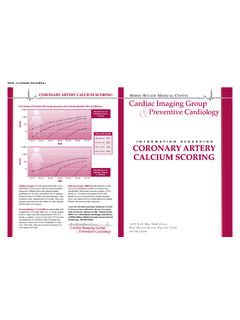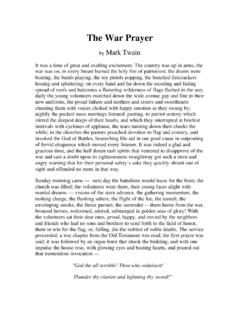Transcription of The Control and Treatment of Slaves - SJC HISTORY …
1 IllesPunishment of slaves4 The Control andTreatment of SlavesSlavery and the lawBetween 1665 and 1833 the slave population of theCaribbean rose from under 50 000 to well over1 100 000. Around the middle of this period in1770, a year for which reasonably accurate figuresare available, some 950 000 Slaves were distributedamong the possessions of five European powers:and byn from:ned innds. AsDuld beerationi Statesnts populationSlavesBritishFrenchDutchSpanis hDanish500 000430 00090000144 00020000428 000379 000750005000018000 Everywhere, except in the Spanish islands, slavesformed the bulk of the population, and every-where their lives were governed by stringent relatively small white populations were onlytoo well aware that their societies depended entire-ly on forced labour, and could only survivethrough the operation of repressive laws. Whitedomination was based on power. This operated atan institutional level, over the legal and economicaspects of slavery, as well as over the Slaves them-selves.
2 Any honour or esteem attached to being a31slave-owner arose only from the power that hecould exercise over the bodies of his Slaves , and thishad to be sanctioned by slave laws. Such lawsmeant that white men and women could exerciseintimate power through punishment, torture andcontrol of all a slave's physical needs. In drawingup and enforcing such laws the slave-owners in theCaribbean, like those in the rest of the New World,created their own version of slavery. They inventedfrom scratch all the ideological and legal underpin-nings of a totally new slave the eighteenth century about 90 per cent ofall Slaves worked. Only the invalids, very youngchildren and the infirm, who made up the other10 per cent were exempt. The vast majority workedon plantations. There, when they were not havingto carry out hard manual labour, they were sub-jected to, or threatened with, flogging and mutila-tion for a wide and constantly increasing variety ofoffences.
3 Slave women were abused by white men,and all - men, women and children - were more orless abandoned to under-nourishment and non-plantation Slaves , the logwood cutters inCentral America, and those in places like theBahamas, the Cayman Islands, Anguilla, Barbudaand the Grenadines, had slightly better lives butwere still subject to very similar slave codes. Thosecodes ran very much to a pattern, regardless of thenationality of those who operated them, but thoseenforced in the British islands were undoubtedlythe most laws and codes in the BritishCaribbeanAlthough slavery was not a condition recognisedunder English law there was little or no oppositionin England before the 1780s, to either the slavetrade or the institution of slavery in the Caribbeancolonies. As a result, the life of a slave in such acolony was dominated by laws drawn up by thelocal Assembly, most of whose members wereslave-owners.
4 These were men concerned primarilywith the protection of property and the Control ofan unwilling workforce, fully aware that such asystem could not survive without a repressive such men, Slaves were chattels, private posses-sions like animals or furniture acquired by pur-chase or inheritance. As a fundamental principle ofEnglish law was the security of property, allowingan owner to do what he liked with his possessions,Inspecting slaves32this t ~-wnelust iIt ;iuwaspropdebt.'inheiundeprottgiveruntil allowregarman;existworemento tleithgrianstaterigicwanSithe :combothrighaim1thei<bruEadmarma>whicopandin took the slave out of the law's jurisdiction. Theowner of a chair could destroy it if he wanted to,just as he could slaughter a cow he might therefore followed that how he treated his slaveswas entirely his own affair. Slaves were privateproperty and, like animals, could be sold to meetdebts or disposed of in accordance with the laws ofinheritance of real estate.
5 This definition of slavesunder British West Indian law denied them anyprotection under English law. Slave-owners weregiven wide discretion in enforcing Control , anduntil late in the eighteenth century the slave codesallowed them to do very much as they liked withregard to every aspect of their Slaves ' lives. Amongmany other things, the law ignored completely theexistence of family ties, gave no protection towomen against overwork, sexual abuse, or ill treat-ment during pregnancy, and laid down no limitsto the punishments that could be inflicted oneither males or females. In the words of one histo-rian of slave society, 'The slave laws legitimized astate of war between blacks and whites, sanctifiedrigid segregation, and institutionalized an earlywarning system against slave revolts.'Such laws began to be passed in the middle ofthe seventeenth century. By 1661 Barbados had acomprehensive slave code.
6 Although this accordedboth masters and Slaves carefully differentiatedrights and obligations, it left the masters withalmost total authority over the life and death oftheir Slaves . The code saw Slaves as 'heathenish' and'brutish', and unfit to be governed by English slave-owner was required to act as a police-man, to suppress any humanitarian feelings hemay have had, and to deal with his Slaves with awhip constantly to hand. The Barbados code wascopied by the Jamaican Assembly three years later,and later formed the basis of all the others enactedin the British Caribbean. Punitive and coerciveclauses formed a major part of all the slave codes,and very little attention was paid to the welfare ofeither men or effect of the laws was to deprive the Slaves ofeven the smallest and most inconsequential of free-doms, and at the same time to restrict their ownersfrom granting even the slightest the most important common features ofthe slave codes were laws designed to prohibit andOwners with new acquisitionssuppress unauthorised movement and the congre-gation of large numbers.
7 Slaves were also bannedfrom possessing weapons, horses and mules, fromsounding horns or beating drums, and from thepractice of secret rituals. Special slave-trial courtscould dispense summary 'justice', but slave-ownerswere given very wide discretion in punishing theirslaves. The courts usually dealt with Slaves whowere recaptured after running away, or who wereaccused of crimes such as theft. Punishment foractual or threatened violence against any whiteperson was very the various slave codes ran to apattern, they all contained individual provisionsreflecting the condition of the society in whichthey were drawn up. In the Bahamas Slaves couldbe flogged for selling such things as liquor, eggs,fruit or vegetables, or if found gambling. InBermuda they were not allowed to wear brightclothes or ornaments, nor even to carry a stickunless.
8 They were decrepit or lame. A MontserratAct of 1693 permitted any white man to kill a slavewho was caught stealing provisions, and if a slavestole anything of value he or she was liable to beflogged and have both ears cut off. Under an Actpassed in the Virgin Islands in 1783, if a slave33struck or opposed any white person the punish-ment was not only flogging but having the nose slitand 'any member cut off. Such provisions formutilation were commonplace. The penal codedeveloped in Jamaica was the most savage of themall, and attempts to modify it were constantlythwarted by the power of the planters in into four pieces. Or he could simply be burntto death, which in Jamaica in 1740 was laid downas the punishment that a slave would incur forstriking a white person. All of these methods ofcapital punishment were in use in Europe duringthe seventeenth and eighteenth centuries, but notas a punishment for such minor crimes as runningaway from work, or for hitting another punishments dealt out both by the courts andby individual slave-owners were very severe.
9 Theiraim was to deter and humiliate, not to 'make thepunishment fit the crime'. The way that ownersruled their Slaves varied from owner to owner, andfrom one society to the next, but there werecommon features. The most important and mostcommon form of punishment was flogging, andpersonal coercion using the whip must be seen asthe denning characteristic of slavery. On any plan-tation, floggings were totally unchecked by anyoutside authority. Brutality and sadism could befound anywhere. Severe floggings were oftenaccompanied by some form of mutilation. Lesssevere whippings and beatings were frequentlycarried out in conjunction with making thosebeing punished commit humiliating or disgustingacts. For urban Slaves not only the whip, but struc-tures such as the stocks and the pillory which werefound in every town, were ever-present remindersof what awaited those who failed to work hard orshow proper death penalty was awarded for what wouldnow be considered relatively minor offences.
10 Anextreme example of this was a Barbados law of1688, which made the theft of items worth morethan 12 pence punishable by death. The penaltywas carried out in a number of barbarous ways, alldesigned to prolong the agony involved as long aspossible, and to present other Slaves with theclearest demonstration of the power their ownersheld over their lives. A slave could be hanged, orbeaten to death while lashed to a cart-wheel, or hecould be hung up in an iron cage until he diedfrom hunger and thirst. Alternatively he could behanged until he was near to death, and thenrevived in order to be disembowelled before beingManumissionWhether a slave could be given his freedom or notwas entirely dependent on his owner. The manu-mission laws were more stringent than in theFrench or Spanish possessions, and owners werereluctant to give freedom, as a large sum had to bedeposited at the local vestry to ensure the newlyfreed man or woman did not become a burden onthe parish.







